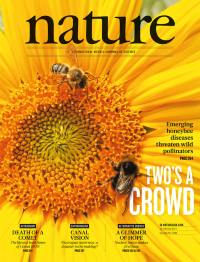Volume 506
-
No. 7489 27 February 2014
Excitons, plasmons and phonons are some of the better known quasiparticles � exotic entities that act in some respects like ordinary particles. New types do not come along all that often but here is one � a fundamentally new many-body particle named the dropleton�. Mackillo Kira and colleagues have identified this new quantum entity, a quantum droplet created when four or more electrons and holes (electronic vacancies) form a tiny correlation bubble via the Coulomb attraction, in direct-gap semiconductors such as gallium arsenide. The cover illustrates the pair-correlation function g(r) of quantum droplets � the central peak of the correlation function shows that electrons and holes are likely to be co-located and the ripples show that otherwise they form regularly spaced shells. (Cover art: Brad Baxley.)
-
No. 7488 20 February 2014
A bumblebee and honeybee collect sunflower nectar. Efficient pollination is vital for both crop production and ecosystem sustainability, and there is evidence to suggest that emerging infectious diseases are contributing to a decline in populations of some important insect pollinators. This study combines laboratory infection experiments and field studies to demonstrate infectivity of two serious honeybee (Apis mellifera) pathogens in a wild pollinator, the bumblebee (Bombus terrestris). Data from across the United Kingdom show that there is co-localization of deformed wing virus (DWV) and the microsporidian parasite Nosema ceranae in the two types of pollinator, and that the honeybee disease can be infectious in bumblebees. This work indicates that wild pollinator populations may be at risk, and unlike managed populations of Apis, they are not protected by intervention from beekeepers. Such a loss of wild pollinators would significantly decrease crop pollination efficiency. Cover123RF/Paul Maguire.
-
No. 7487 13 February 2014
A representation of hysteresis in a quantized superfluid atomtronic circuit based on an image of a trapped ring-shaped BoseEinstein condensate (BEC). Hysteresis, a phenomenon by which the physical properties of a system depend strongly on the history of the applied perturbation, is widely exploited in electronic circuits including hard disk drives and flux-gate magnetometers and is essential to the function of radio-frequency SQUIDs (superconducting quantum interference devices). Hysteresis is also fundamental to superfluidity and has been predicted to occur in superfluid atomic-gases, such as BECs. Gretchen Campbell and colleagues now report the first direct detection of hysteresis between quantized circulation states in a circuit formed from a ring of superfluid BEC obstructed by a rotating weak link. The presence of hysteresis in this system is of importance in the emerging field of atomtronics�, in which ultracold atoms have a role analogous to that of the electrons in electronics. Controlled hysteresis in atomtronic circuits may prove to be a crucial feature for the development of practical devices. Cover: Emily Edwards.
-
No. 7486 6 February 2014
Sunrise with Brazil nut tree in Senador Guiomard, Acre, Brazil. Our understanding of the sensitivity of the terrestrial carbon budget to climate anomalies is based largely on modelling and small-scale ecosystem studies and remains uncertain. That means that although the fate of the vast amounts of carbon stored as Amazon rainforest biomass is crucial to future climate trends it is not clear whether the Amazon will remain a carbon sink or become a source � and a driver of climate change. A new analysis of seasonal and annual carbon balances based on carbon dioxide and monoxide measurements for anomalously dry and wet years suggests that water availability has an important role in determining the carbon balance in the Amazon basin. During 2010, drought reduced plant production and limited the amount of carbon that could be stored in vegetation; at the same time large amounts of carbon were released by fire. The region was carbon neutral during the wet year, 2011, because of reduced carbon loss through fires and increased carbon uptake by vegetation. Cover: P&R Fotos/AGR Fotostock & robertharding.com




